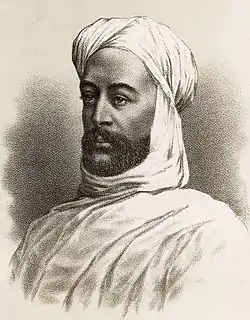Danagla
The Danagla ("People of Dongola", sg. Dongolawi) are a collection of Nubian tribes and peoples in northern Sudan, primarily settling between the third Nile cataract and al Dabbah. Along with Halfawi, Sikot, Mahas, they form a significant part of the indigenous Nubian peoples in Sudan. In addition, they have historically lived in proximity to their Shaigiya and Ja'alin neighbors.

They originally speak Andaandi which is one of the Nubian languages spoken in Northern Sudan & Southern Egypt.[1] it is still spoken by the majority of the population along side with the Sudanese Arabic dialect.
History and Etymology
Originating from ancient Nubia , the word danagla comes from the plural form of the Nubian word meaning Red Brick. Danaglas are known to practice and preserve culture honouring the legacy of the Nubian civilisation. Although some Danagla have mixed with Arab tribes during the spread of Islam in Sudan and primarily during Anglo Egyption Sudan forming the Jabiriah, Badiriah and Hakamab tribes, most are believed to have remained mostly unmixed; a concept which danagla take pride in but is always under criticism and debate due to the ethnocentrism it sparks.[2] Furthermore, some have been mixed with Mahas and other Nubian tribes.[3]
Genetics
According to Y-DNA analysis by Hassan et al (2008), around 44% of Nubians and danaglas generally in Sudan carry the haplogroup J in individually varied but rather small percentages. The remainder mainly belong to the E1b1b clade (23%). Both paternal lineages are also common among local Afroasiatic-speaking populations. [4]
Thus it's observed that approximately 83% of their Nubian samples carried various subclades of the Africa-centered macrohaplogroup L. Of these mtDNA lineages, the most frequently borne clade was L3 (30.8%), followed by the L0a (20.6%), L2 (10.3%), L1 (6.9%), L4 (6.9%) and L5 (6.9%) haplogroups. The remaining 17% of Nubians belonged to sublineages of the Eurasian macrohaplogroups M (3.4% M/D, 3.4% M1) and N (3.4% N1a, 3.4% preHV1, 3.4% R/U6a1). These results can be used as rough estimates of genetics most Nubians hold.
Notes
- Reinisch 1879, p. VII.
- "قبيلة الدناقلة". maraga.ahlamontada.com (in Arabic). Retrieved 2020-08-25.
- "دناقلة", ويكيبيديا (in Arabic), 2020-07-18, retrieved 2020-08-25
- Hollfelder, Nina; Schlebusch, Carina M.; Günther, Torsten; Babiker, Hiba; Hassan, Hisham Y.; Jakobsson, Mattias (2017-08-24). "Northeast African genomic variation shaped by the continuity of indigenous groups and Eurasian migrations". PLoS Genetics. 13 (8). doi:10.1371/journal.pgen.1006976. ISSN 1553-7390. PMC 5587336. PMID 28837655.
Literature
- Bjokelo, Anders (2003). Prelude to the Mahdiyya: Peasants and Traders in the Shendi Region, 1821-1851. Cambridge University Press. ISBN 0521534445.CS1 maint: ref=harv (link)
- Adams, William Y. (1977). Nubia. Corridor to Africa. Princeton University Press. ISBN 978-0-691-09370-3.CS1 maint: ref=harv (link)
- Reinisch, Leo (1879). Nuba-Sprache. Erster Theil. Gramamtik und Texte. Wilhelm Braumüller.CS1 maint: ref=harv (link)